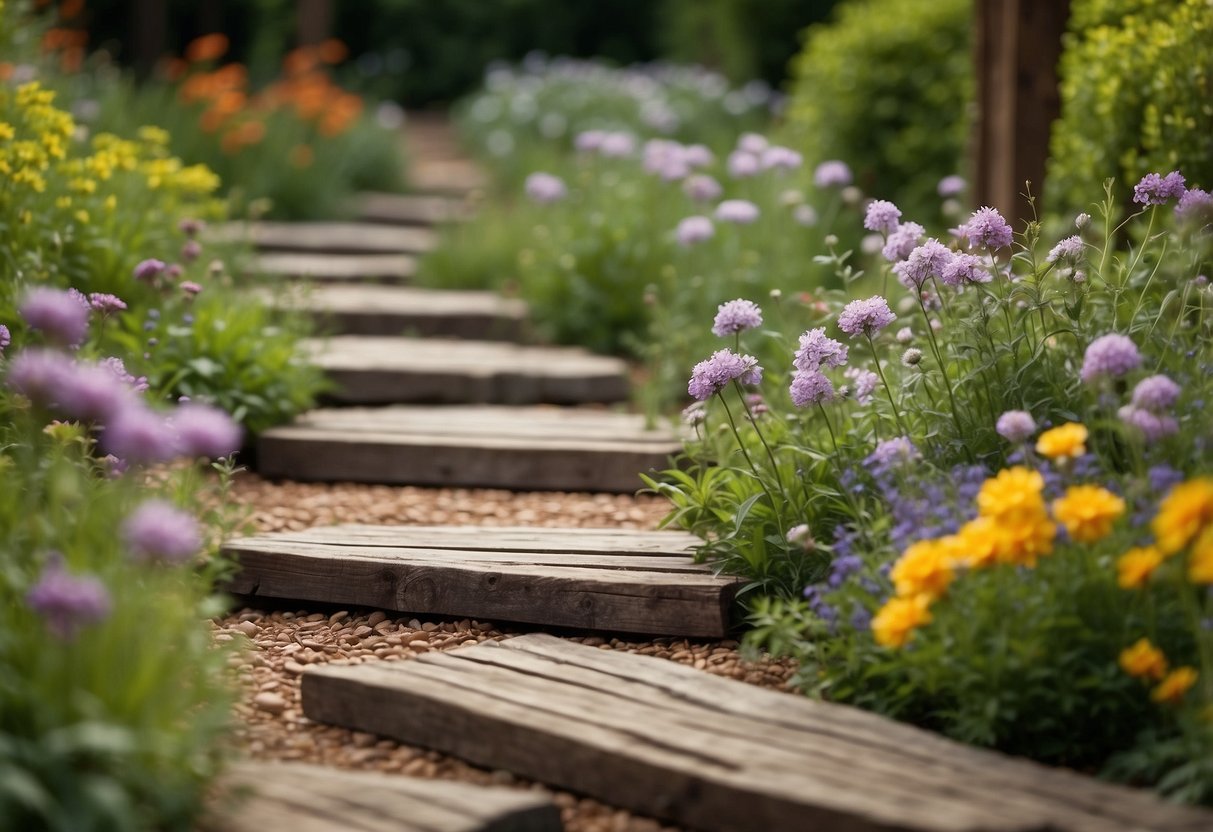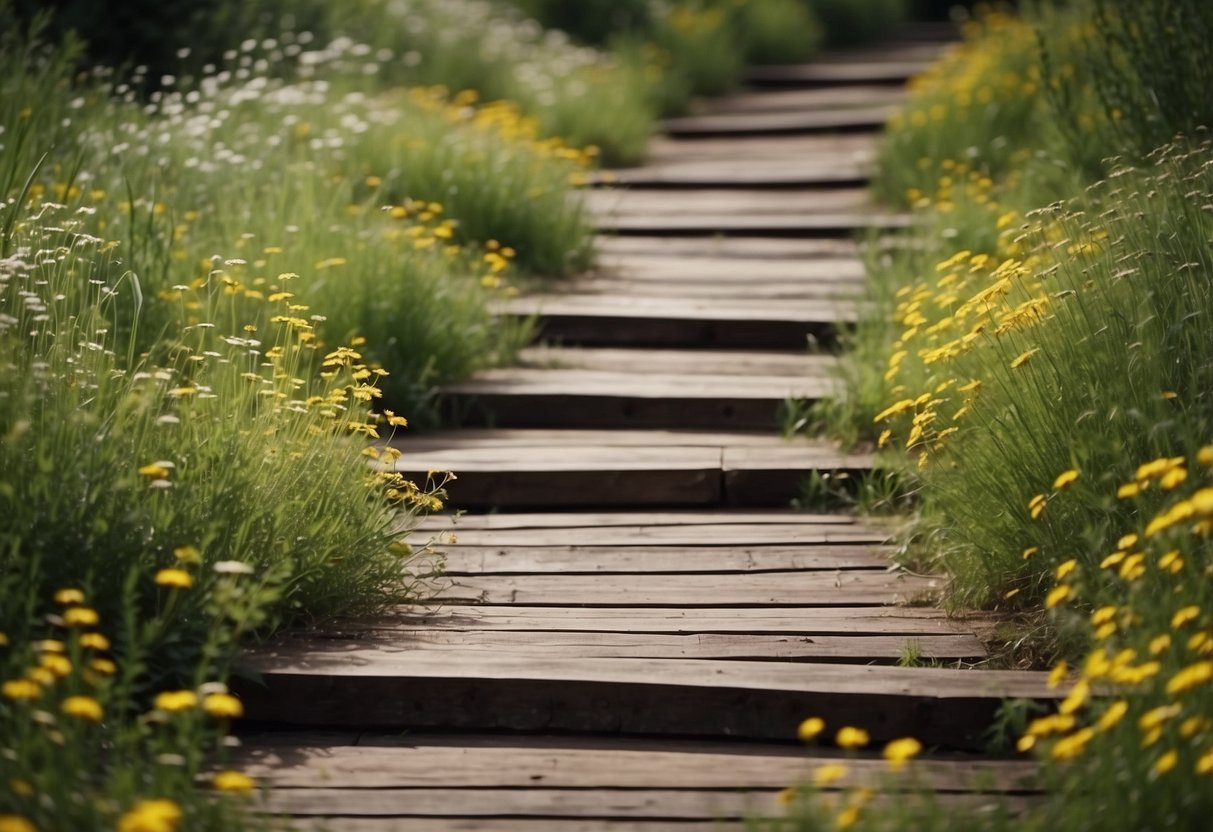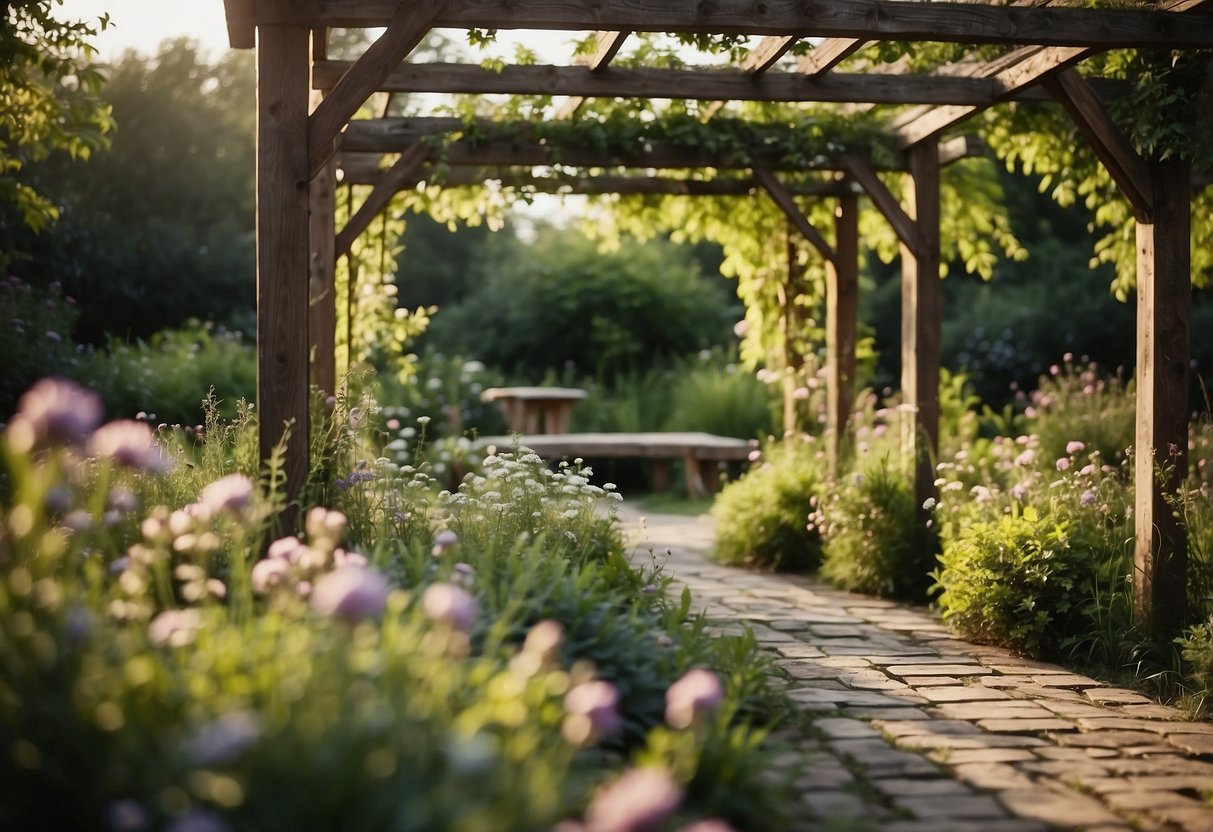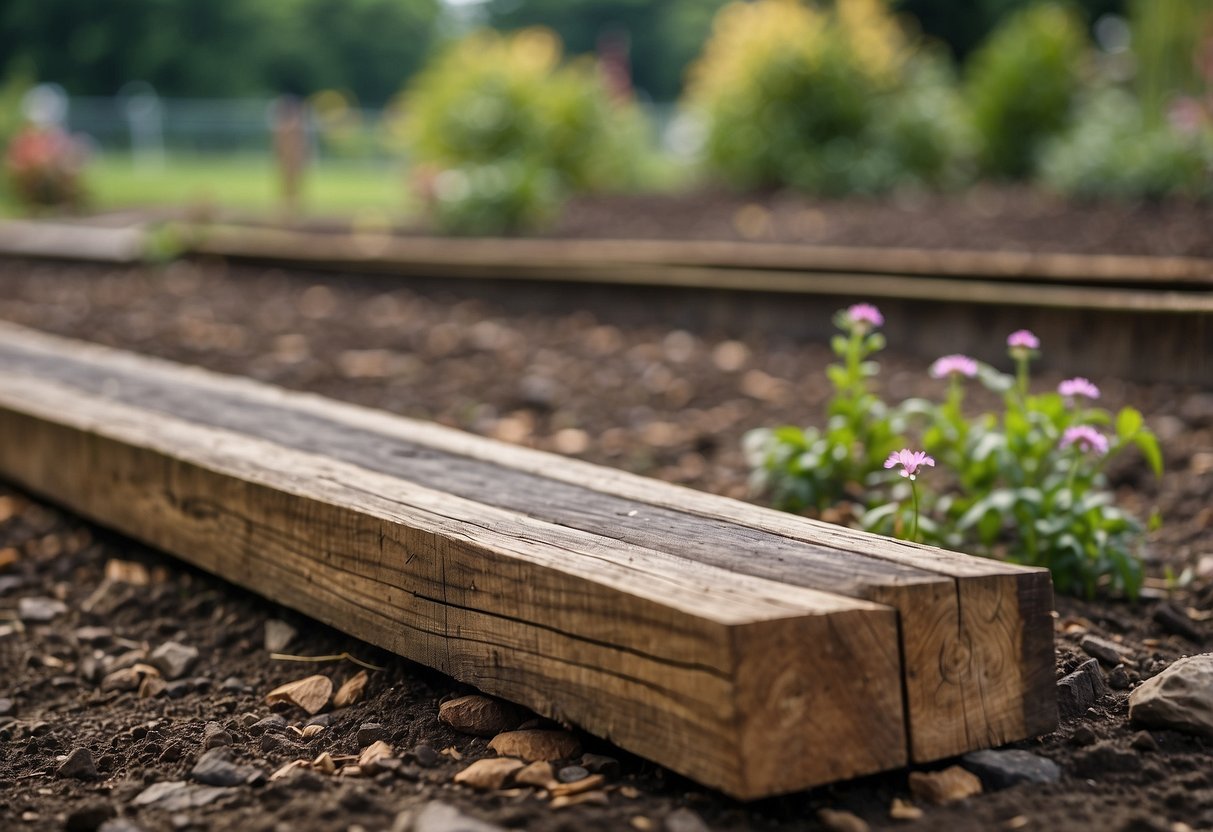Old Railway Sleepers Garden Ideas: Transform Your Outdoor Space
Transform your garden into a unique and charming space using old railway sleepers. These sturdy beams of wood are perfect for adding a rustic touch to your outdoor area while offering practical solutions for various landscaping needs.

Why should you consider old railway sleepers for your garden? They are incredibly versatile and can be used in multiple creative ways to enhance the aesthetics and functionality of your garden. From edging pathways to constructing raised beds, the possibilities are endless.
1) Raised Garden Beds with Sleepers

Raised garden beds with railway sleepers are a great choice for your garden. You can use new or used sleepers to create sturdy and stylish beds.
Stack the sleepers to your desired height. Make sure they are level.
Using sleepers that are untreated ensures your plants are safe. Check out more ideas here.
Rustic Sleeper Pathways

Using old railway sleepers to create rustic pathways in your garden can add a charming and vintage look.
Begin by marking out the path with stakes and string. Remove the sod and excavate the area to a depth of about 4 inches. Lay down weed barrier fabric to prevent weeds from growing through.
Place the railway sleepers on top, ensuring they are level and spaced evenly apart. This setup not only looks great but also makes for a sturdy walkway.
For added stability, you can anchor the sleepers by driving stakes into the ground and attaching them with bolts or screws.
3) Sleeper Retaining Walls

Using old railway sleepers to build retaining walls can be a great way to add structure to your garden. They provide a rustic charm that fits well with outdoor spaces.
You can stack the sleepers horizontally or place them vertically for a different look. Either way, they’re sturdy and durable.
For a neat finish, try to ensure they are level and secure. This makes them not only functional but also pleasing to the eye.
Check out these retaining wall projects for more inspiration and ideas.
4) Vertical Sleeper Garden Fences

Vertical sleeper garden fences can add both structure and style to your outdoor space. They are great for creating privacy while still looking natural.
To install, dig a hole deep enough to secure each sleeper firmly in the ground. Use heavy-duty spades for the task.
Treat the wood to protect it from the elements. This ensures your fence lasts longer.
For added charm, you can grow climbing plants, like ivy or roses, around the sleepers. This makes your garden fence look even more enchanting and lush.
5) Sleeper Bench Seats

Creating a sleeper bench seat adds a rustic charm to your garden. You can use old railway sleepers to design a sturdy and unique bench.
Start by placing two or three sleepers as the base. Add another layer on top to form the seat. Secure the pieces to prevent any wobbling.
If you want some inspiration, check out different designs here. Using reclaimed wood keeps the natural, weathered look intact, adding character to your outdoor space.
Planters Made from Sleepers

Using old railway sleepers to create planters is a great way to add a rustic touch to your garden. These wooden beams are sturdy and have a natural charm that can enhance any outdoor space.
Simply stack the sleepers to your desired height and fill the space with soil. This method works well for both small flower beds and larger vegetable gardens.
For added appeal, you can plant low-growing foliage between the gaps of stacked sleepers. This softens the look and makes the structure blend more naturally with your garden. For more ideas, check out these raised planter projects.
7) Sleepers for Garden Edging

Using old railway sleepers for garden edging can add a rustic charm to your outdoor space. These sturdy, wooden beams create clear boundaries for your garden beds and pathways.
They are not only durable but also require minimal maintenance when treated properly. You can easily install them by digging a trench, placing the sleepers, and securing them with stakes.
For more ideas, you can check out how-tos and tips. Garden sleepers work well with a variety of garden styles and can be cut to fit any design.
8) Sleeper Steps in Sloped Gardens

Creating steps with railway sleepers is a great way to make sloped areas in your garden more accessible. These steps can blend naturally with the landscape, adding a rustic charm.
To build sleeper steps, first, mark out your desired path. Excavate the area to make room for each sleeper.
Place each sleeper securely into the ground. You might need to anchor them with stakes for extra stability.
You can soften the look by planting low-growing foliage in the gaps. This will add a touch of greenery and help the steps blend into your garden.
Adding boulders on the side of each step can also enhance the natural appearance.
9) Sleeper Pergola Frames

Transform your garden by building a pergola with railway sleepers. This idea adds charm and offers a perfect spot for climbing plants.
You can arrange the sleepers vertically to create the posts and horizontally for the top beams. It’s a simple design that stands out.
For added beauty, train vines or hanging plants to grow on your pergola. It will turn your garden into a cozy retreat. Check out more ideas here.
10) Sleeper Water Features

Adding a water feature to your garden with old railway sleepers can create a calming focal point. You can use the sleepers to build ponds, waterfalls, or decorative streams.
Arrange the sleepers to form a sturdy frame. Line it with a pond liner to hold the water. Plants and fish can bring life to your new feature.
For a rustic look, add an old well pump or wooden barrels. These elements can create a serene ambiance. A cascading waterfall made from steel and railway beams provides a modern twist.
Explore more ideas from railwaysleepers.com and Pinterest.
Choosing The Right Railway Sleepers

Selecting the proper railway sleepers for your garden can impact the appearance and durability of your projects. Consider the type of wood and the source of the sleepers to ensure they suit your needs.
Types Of Railway Sleepers
Railway sleepers come in various materials like wood, concrete, and metal. For garden projects, wooden sleepers are most popular due to their classic look and relative ease of handling.
-
Hardwood sleepers: These are durable and can last many years. They often come from species like oak and tropical hardwoods.
-
Softwood sleepers: Lighter and easier to work with, they might need treatment to last outdoors.
Old railway sleepers may be treated with creosote, a substance to consider avoiding if you are worried about plant safety. Look for untreated or lightly treated options for a healthier garden environment.
Sourcing Old Railway Sleepers
Finding old railway sleepers requires some effort. You can start by checking with local garden centers and landscape suppliers. They often carry reclaimed sleepers for decoration, edging, or structural use in gardens.
Additionally, online marketplaces and specialized reclamation yards can be great places to find these materials. Make sure to ask about the history and treatment of the sleepers, especially if you plan to use them near edible plants.
Another option is contacting railway companies or construction firms that may have old sleepers from dismantled tracks. This can sometimes be a more economical choice and ensures the authenticity of the reclaimed materials.
Preparing Your Garden For Railway Sleepers

Getting ready to install railway sleepers in your garden requires careful planning. It’s essential to handle the sleepers safely and have the right tools and materials.
Safety Tips For Handling Sleepers
Using railway sleepers can be a great addition to your garden, but you need to handle them safely. Wear gloves to protect your hands from splinters and dust. Use safety goggles to shield your eyes from flying debris while cutting or moving the sleepers.
Sleepers are heavy, so always lift with your legs and not your back to avoid injury. Work with a friend if possible; two people can move the sleepers more safely than one.
If you’re working with old sleepers, avoid ones treated with creosote. This chemical can be harmful to plants and humans. Look for untreated or eco-friendly options instead.
Tools And Materials Needed
Before starting your project, gather the necessary tools and materials. You’ll need a shovel to dig the area where the sleepers will go. If you’re building a raised bed, a saw will be essential to cut the sleepers to the right size.
A measuring tape and level are important to ensure your sleepers are correctly placed. Wood screws and a power drill are needed for securing the sleepers together.
A weed barrier fabric can help prevent weeds from growing around the sleepers. Stakes and string are useful for marking out the area where you’ll place the sleepers.







